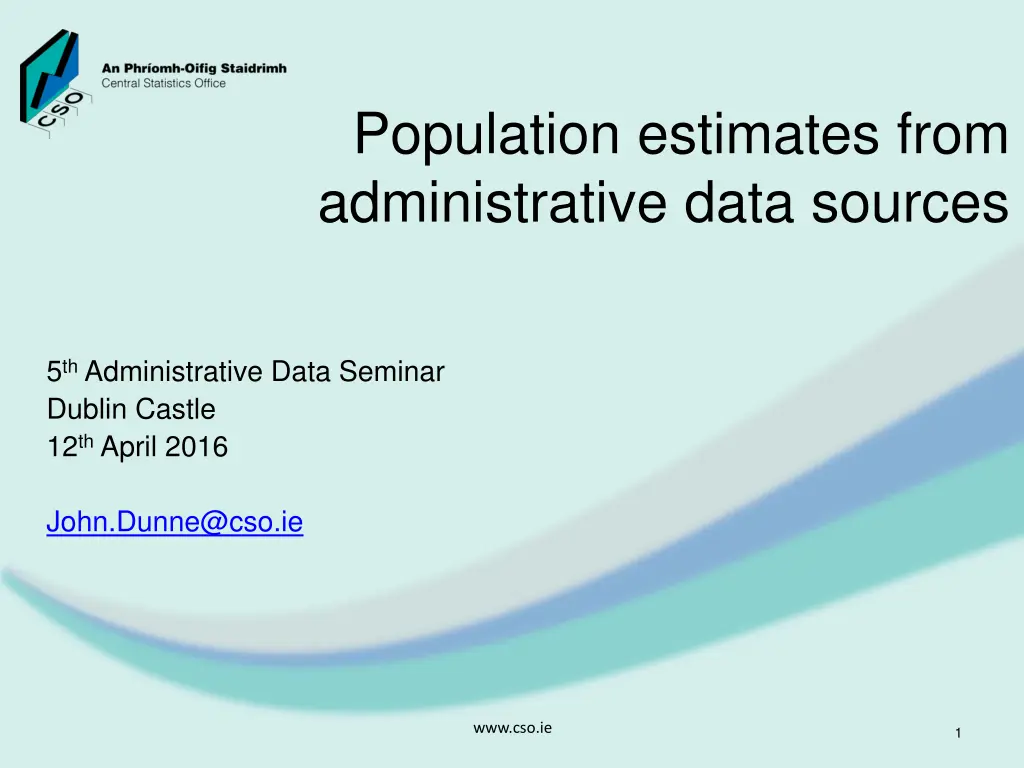
Innovative Population Estimation Methods and Dual System Estimation Framework
Explore innovative approaches to population estimation using administrative data sources and learn about the application of the Dual System Estimation method for accurate results. Discover how to identify and address overcoverage issues in population estimates.
Download Presentation

Please find below an Image/Link to download the presentation.
The content on the website is provided AS IS for your information and personal use only. It may not be sold, licensed, or shared on other websites without obtaining consent from the author. If you encounter any issues during the download, it is possible that the publisher has removed the file from their server.
You are allowed to download the files provided on this website for personal or commercial use, subject to the condition that they are used lawfully. All files are the property of their respective owners.
The content on the website is provided AS IS for your information and personal use only. It may not be sold, licensed, or shared on other websites without obtaining consent from the author.
E N D
Presentation Transcript
Population estimates from administrative data sources 5thAdministrative Data Seminar Dublin Castle 12thApril 2016 John.Dunne@cso.ie www.cso.ie 1
Overview Traditional approach Proposed new approach Extending to migration (in and out) Concluding remarks
Traditional Component method Quality Profile Census years Time
New approach data signs of life Two datasets PAR (excluding drivers) DL Driver licence renewals Sources (Cradle to Grave) - Births - Child benefit * - Post primary - Higher Ed - Further Ed - Employee - Self Employed - Social Welfare - Drivers *** - Medical ** - Pensions * - Deaths PAR - Person Activity Register (CSOPPSN) 2011 (4.3m) Admin Active Population during year Signs of life Does PAR have undercount? Does PAR have overcount?
New approach population concepts UI UII UA UB de facto census night definition usually resident population hypothetical PAR population hypothetical DL population Assume UII = UA = UB
Dual System Estimation - undercoverage Population (N) PAR (x) E[N] = x n/m Assumptions - Independence - Matching - Catchability ? - No overcount ? See Wolter (1986) PAR DL (m) DL (n) But we can look for signs of overcount by trimming PAR
Looking for overcoverage Remove suspicious records step by step Observe behaviour of population estimate if stable OK drops before stabilising => overcoverage? Suspicious records? Low pay and no other activity Steps of 1k Method is called Trimmed Dual System Estimation
DSE Population Estimates Assuming no overcoverage Adjust for undercoverage using DSE model
Quality Profile Census years Next steps Time Coverage on PAR to enhance quality PCRS, Child benefit and State pension payments .. Robustness - dependency on each data source Bias further investigate age group 20-40 Timeliness strong partnerships with data providers
Extension to Migration (In and Out) Good quality net migration from Population estimates Estimating immigration and emigration not so easy We can use DSE model to look at problem a differently
Population 2 Population 1 Outflow = Deaths + Emigration Stayers Inflow = Births + Immigration
PAR1 PAR2 Population 2 Population 1 PAR2 PAR1 DL1 DL2 Estimating a shared population methodology Chao 2008 DL1 DL2
PAR1 PAR2 Population 2 Population 1 PAR1 DL2 DL1 PAR2 DL1 DL2 is NULL !!!!!
Twodirections 1. Estimate stayers in PAR1 2. Gross up to Population 1 or 1. Estimate stayers in PAR2 2. Gross up to Population 2 Two methods - DSE - Based on Hypergeometric distribution using Par1, DL2 and Population 2 or PAR2, DL1 and Population 1 Preference for backwards Direction (DL1) ?
Emerging census opportunity Postcodes and small areas Can other census attributes be derived from admin data sources and existing surveys
Concluding remarks Only focussed on one aspect Admin data = Many new possibilities .. strong partnerships .. change the way we look at problems .. new methods, new tools Trust and Responsibility
Background references Chao et al (2008) ,The Petersen Lincoln estimator and its extension to estimate the size of a shared population, Biometrical Journal 50 (2008) 6, 957 970 Wolter (1986), Some coverage error models for census data, Journal of the American Statistical Association 81 338 346 Zhang and Dunne (2016),Trimmed Dual System Estimation, in Capture-recapture methods for the Social and Medical Sciences, forthcoming
